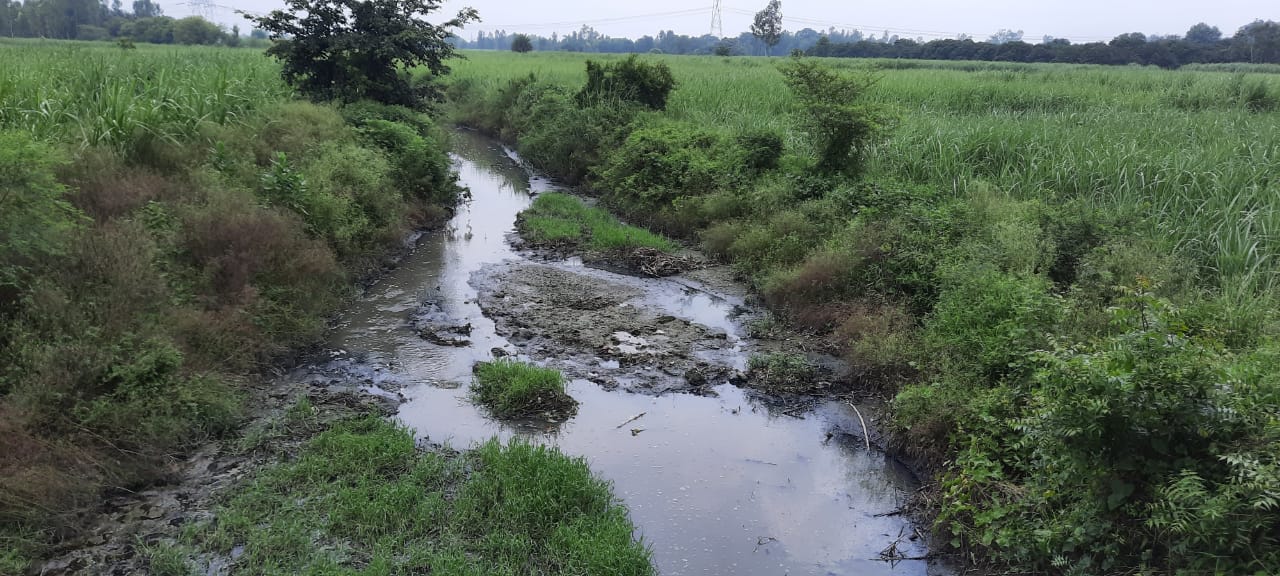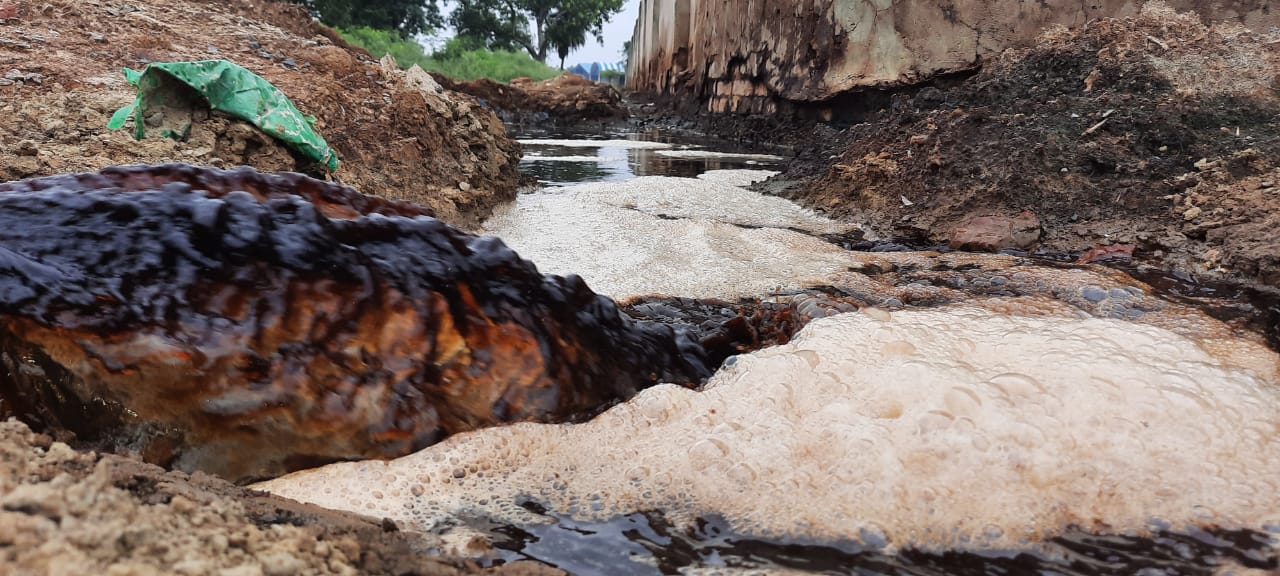A sugar mill in Sitapur, UP is in the eye of the storm for damaging farmlands and crops
A sugar factory in Sitapur, Uttar Pradesh is allegedly causing misery in a neighbouring village by discharging effluents into the open. Villagers claim their land is turning infertile and crop produce is reducing too. Both factory administration and pollution control board officials deny allegations.

Juhri (Sitapur), Uttar Pradesh
The 800 odd villagers of Juhri village in Sitapur district are in considerable distress. “No sooner does a breeze start blowing, there is an unbearable stench that shrouds the village,” Santosh, an inhabitant of Juhri, told Gaon Connection. “It is so bad that it has begun to affect our appetite,” he added. Santosh claimed that because of that three of his family members were sick.
Bad odour is not the only problem in this village located about 90 kilometres from the state capital Lucknow. Their farm lands are turning infertile and crops are wilting due to the contaminated water that often flows into their fields, Juhri’s farmers complain.
The all-pervading foul smell and the toxic effluent comes from a nearby sugar mill, claim the villagers, and the situation turns worse during the monsoon months, such as now, when wastewater from the factory overflows into their agricultural fields.
“If we are not watchful enough, and our cattle drink this water, they fall sick,” Santosh said.

Also Read: ‘It is poison, not water, that comes out of the handpumps’
According to the villagers, the sugar mill — Dalmia Sugar Mills Jawaharpur — located in Khairabad block routinely discharges the filthy water from its lagoon (pond-like bodies of water or basins designed to receive, hold, and treat wastewater). They allege that thousands of litres of water are let out at night, and they fill up the nearby drains of the village, seep into the agricultural lands and pollute the groundwater too.
The sugar mill that was established in 2007, has a total cane crushing capacity of 7,500 tonnes of cane per day. Its total distillery capacity is 120 kilo litres per day.
However, the factory officials deny all the allegations. “There is no water in the sugar mill and the lagoon is empty,” TN Singh, unit head of Dalmia Sugar Mill, Jawaharpur, told Gaon Connection. “Therefore there is no water being let out of the mills. In fact, the mill has been helping out farmers with water for their irrigation,” he claimed.
But, when Gaon Connection visited the site on July 27, it found the lagoon of the sugar mill where the untreated water is collected to be full. Water was seeping out despite the boundary walls of the factory. Discoloured and foul smelling water gushed out of a pipe.
“It is horrible, because the water seeps out and runs into our fields damaging our crops. Not just that, it also reduces our roads to slush. Stepping out becomes a huge problem,” Santosh complained.

Farmers lose crops
Villagers allege that toxic effluent from the factory often leads to crop losses. “I have nine bighas [1.2 hectares] of land bordering the boundary of the sugar mill. The dirty water has ruined my paddy,” Kamlesh Gautam, a farmer from Juhri, complained to Gaon Connection.
In the previous season too, 45-year-old Gautam claimed that four bighas of his wheat crop were ruined by the effluent water. “Each bigha of land yields six quintals of wheat. When I complained to the mill, they gave me compensation of five thousand rupees only, and I had to be satisfied with that,” Gautam said. He pointed to the poisonous water in his fields. “I know the crops look good, but they will yield no grains in all that greenery,” he said emotionally.

This is not a recent problem, said Gautam. The menace of effluent-discharge has been happening ever since the sugar mill came up in 2007. “We have tried complaining, but it has had no effect,” he shrugged.
Fear of disease
Residents of Juhri complain that wastewater from the sugar mill creates unhygienic conditions in the village leading to a spread of diseases. “The ponds and other water bodies in our village are so contaminated that even our animals won’t drink from them,” Girish Kumar, a young farmer and inhabitant of Juhri, told Gaon Connection.
Flies and swarms of mosquitoes have made it impossible to even stand long enough to cut grass for our animals, he complained. “I fear disease is never far away. Yet the sugar mill has not bothered even once to spray the area to keep away flies and mosquitoes,” Girish Kumar continued.

Pollution from sugar mills
Some of the most polluting industries are sugar mills and distilleries. They figure in the list of India’s 17 highest-polluting industries, discharging water into the Ganga River. It is also a water-intensive industry with huge volumes of water being consumed right from the beginning of the sugar manufacturing process, beginning with the cultivation of sugarcanes, right till the time it is made into sugar.
The sugar mills are third in the list of industries that generate the maximum amount of wastewater, much of which is released in the form of effluence. Sitapur has as many as four sugar mills located in it.
“Sugar mills play a major role in polluting water bodies and land by discharging huge amounts of wastewater. During the crushing season, these mills discharge large quantities of effluent per day without any treatment or partial treatment,” Sanjay Arora, principal scientist, ICAR-Central Soil Salinity Research Institute, regional research station, Lucknow, told Gaon Connection.
According to him, sugar mill effluent contains a high magnitude of pollution load and its continuous harmfully affects the crops when used for irrigation. As a result, a higher amount of various elements get accumulated in the soil and make it polluted.
“These wastewaters have high BOD [biological oxygen demand] and COD [chemical oxygen demand] as well as appreciable content of carbonates and bi-carbonates that degrade the soil health and may turn the soil to sodic land (usar) and also adversely affects the microbial activity of soil,” said Arora. “If these waters are used for a long time, it may even make the soil barren and uncultivable,” he warned.
Also Read: Sonbhadra: The darker aspect of the golden glow

An official denial
Both the factory administration and the pollution control board officials deny allegations of the villagers. On being contacted, the environmental engineer Chandresh Kumar, State Pollution Control Board in Lucknow, said the Jawaharpur sugar mill is closed between May and October when overhauling of the machinery, etc. is carried out. “All environmental guidelines are being followed,” he insisted.
“Maybe some of the water seeped out into the drains because of the rains. But that will be investigated,” he told Gaon Connection.
Meanwhile, the inhabitants of Juhri still have no respite from the stench that has become their constant companion. They live in fear that their water sources are contaminated by the effluents and watch helplessly as their crops lose their vitality.

